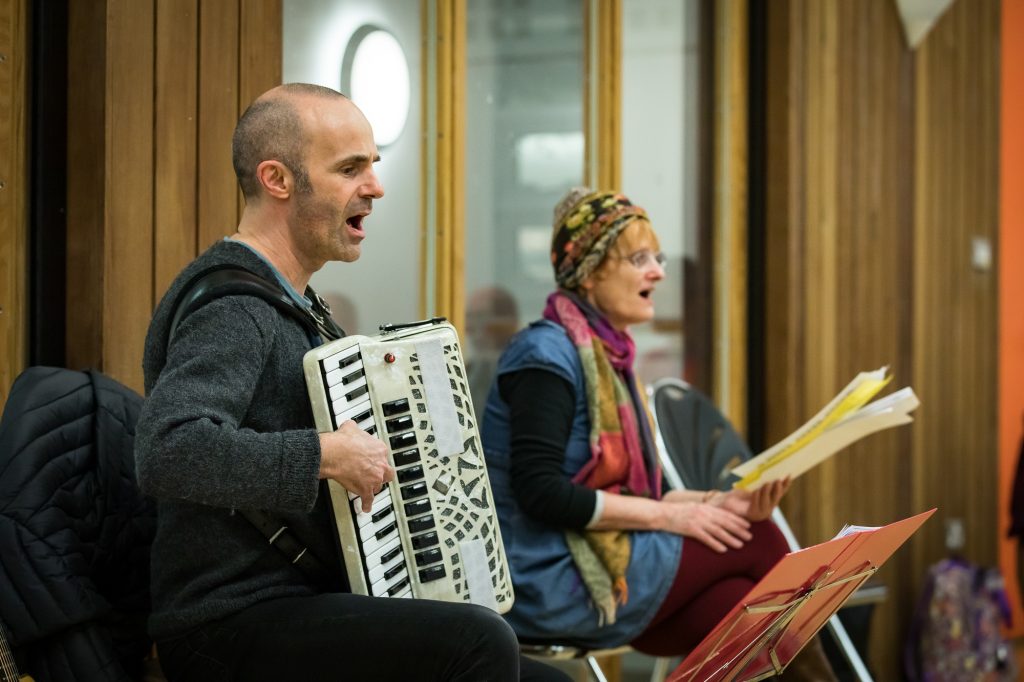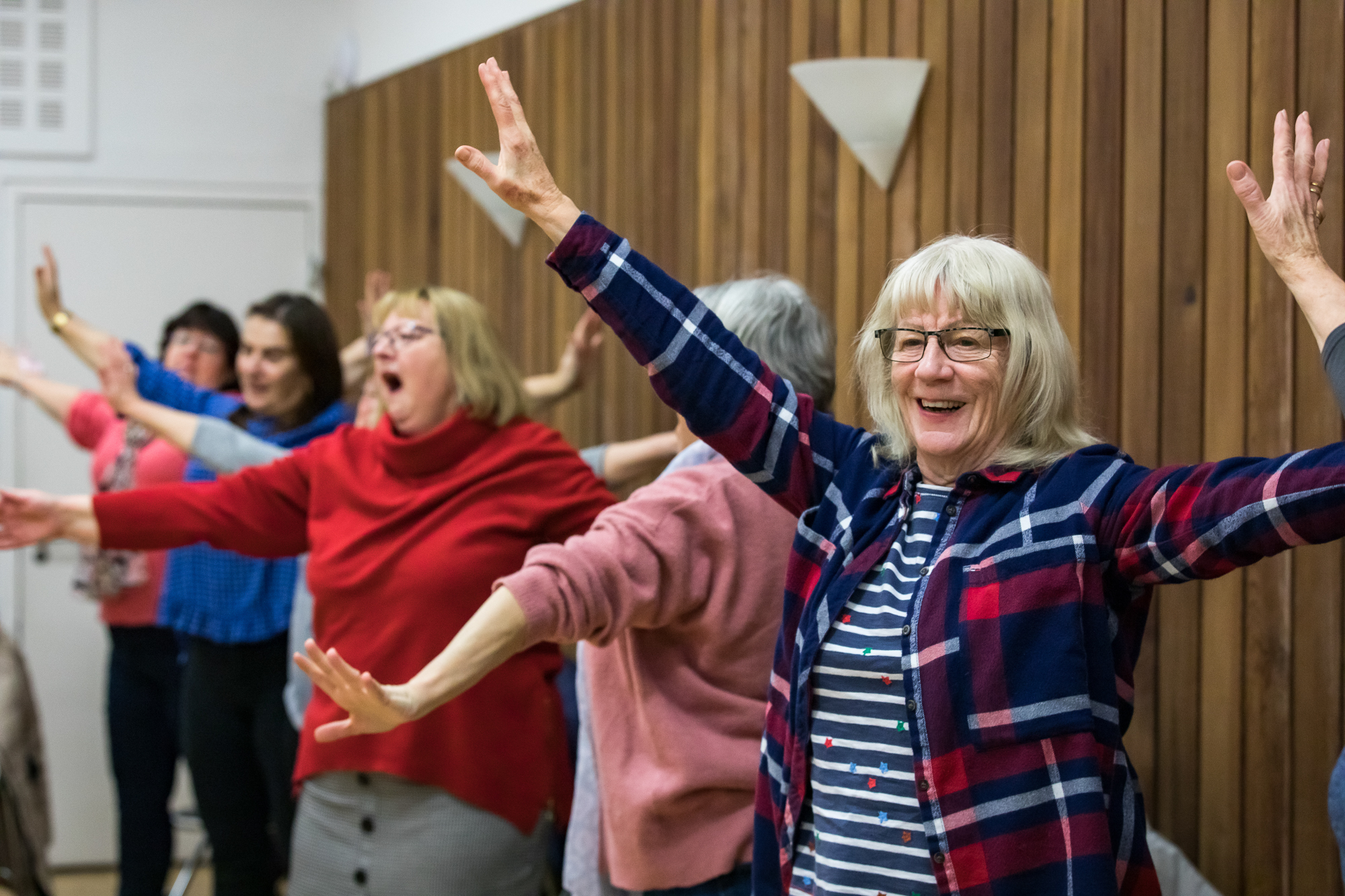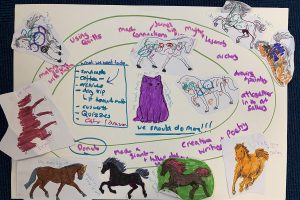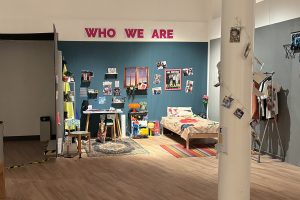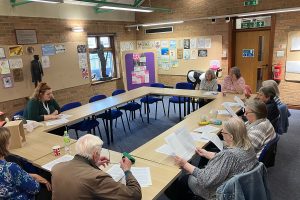What is Breathe & Connect?
Breathe & Connect is a creative health programme using singing, breathing, relaxation and movement to improve lung health. It was developed by darts, Doncaster’s Creative Health & Learning charity, and based on over 30 years experience of delivering dance, movement and singing within a range of contexts.
Doncaster has high prevalence of respiratory disease, and consequently referrals into secondary care respiratory services are high. Pulmonary Rehabilitation is receiving a higher number of referrals than previous years and with COVID-19 and workforce recruitment challenges, waiting lists have grown significantly.
Breathe & Connect was initially developed as a pilot for people with Long Covid or other long-term breathing-related conditions. The pilot enabled darts Core and Freelance artists to work collaboratively with each other, and with health professionals, to understand the health and social impacts of Long Covid and breathing pattern disorder. The artists worked together, and with groups of Doncaster adults, to test and refine their approach, adapting the model to respond to the specific needs of Long Covid and other respiratory conditions.
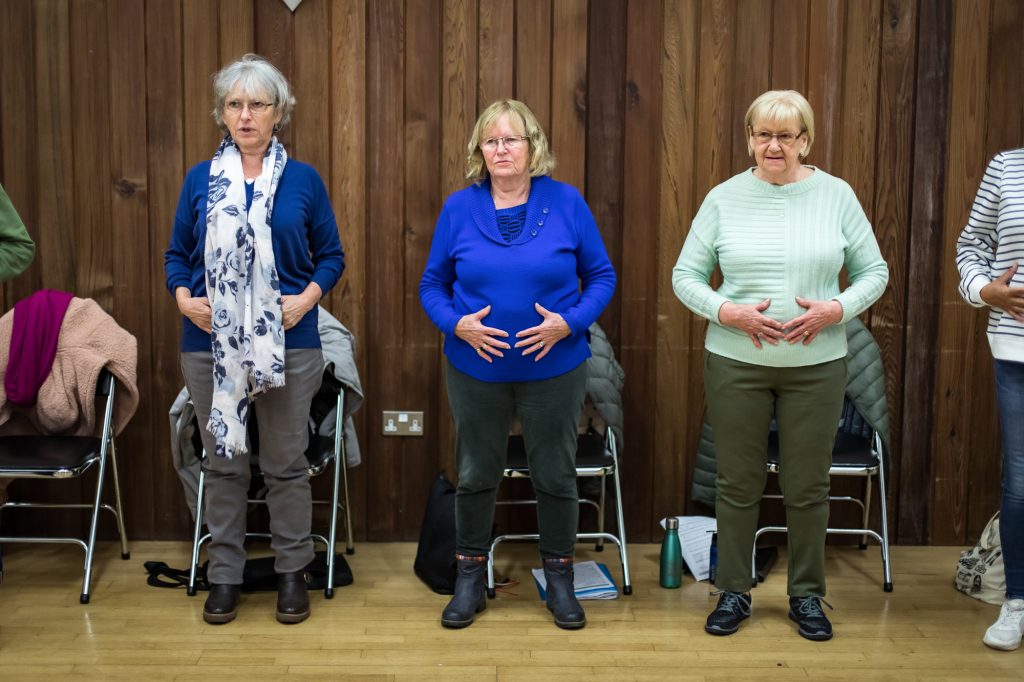
The programme is made up of seven weekly sessions (a ‘block’) at The Point in central Doncaster, a fully accessible, welcoming and non-clinical public building. A dancer and musician collaboratively plan and lead the sessions, with a graded approach that starts with movement and breathing activity that increases stamina and strength each week. Activity is informed by physiotherapy approaches, movement is led by dancers (many of whom have had training in postural stability), and singing is led by musicians with a wealth of experience and training, including singing for lung health.
The programme is currently commissioned and co-designed by Doncaster and Bassetlaw Teaching Hospitals NHS Foundation Trust, who refer patients with respiratory conditions and a lower level of physical ability, who would normally decline any exercise intervention / Pulmonary Rehab, or would opt for a home exercise programme. Activity responds to each participant’s mobility, stamina and need. Group size is intentionally small – limited to a maximum of ten people, and impacts have been significant. Success is measured following a patient satisfaction questionnaire, demonstrating improved clinical outcomes based on a reduction in Dysponea and Nijmegan scores, and a CAT questionnaire (issued by DBTH Physiotherapy) for completion at the final Breathe and Connect Session.
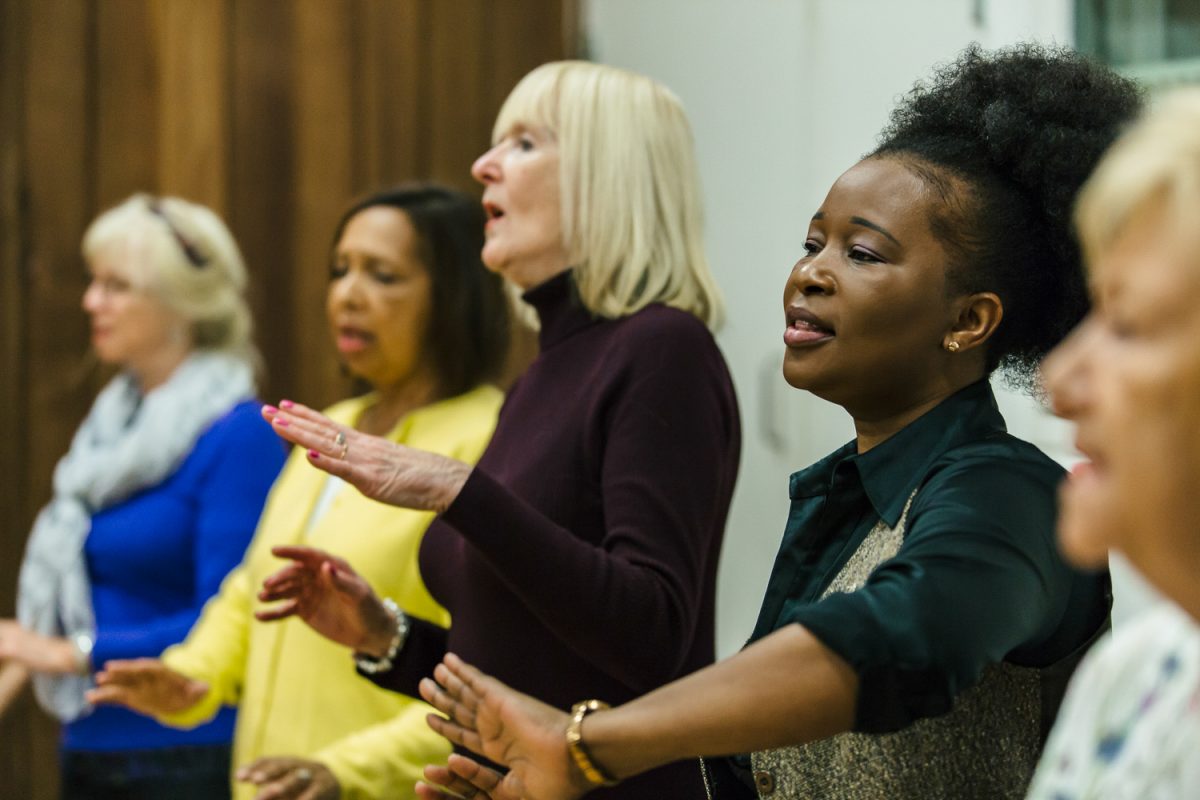
Impacts to date include a reduction in waiting times from 12 months to 4-6 weeks. Results demonstrate that those who attended Breathe and Connect have reported a reduction in symptoms, better understanding of Breathing Pattern Disorder, improvement in control of symptoms, and increased confidence to manage their symptoms. Patient experience has also proven to be extremely positive as captured through the satisfaction questionnaires. Breathe and Connect has freed up clinical capacity to provide more Pulmonary Rehab assessments for high-priority patients at risk of hospital admission/deterioration. Of those who completed the programme (defined as attending 4+ of the seven sessions), 47-59% of patients demonstrated improved clinical outcomes based on a reduction in Dysponea and Nijmegan scores respectively. 94% rated their care as very good, and 100% reported that they would recommend the group to friends or family. 81% of participants reported a better understanding of their condition, 69% reported better symptom control and 75% reported improved confidence to manage their symptoms.
‘From a collaboration perspective, working with the darts team has proven invaluable in creating stronger links with non-healthcare organisations who also share the same vision of improving health outcomes and addressing inequalities.’ (Laura Lomas, Clinical Lead Physiotherapist at Doncaster Royal Infirmary)
Below are some short individual case studies to illustrate patient journeys. All names have been changed.
Sarah has chronic fatigue and had been struggling to manage this. She had been ill, and then contracted Covid-19 before finding out about the Breathe & Connect sessions. She told us:
‘I arrived at the first session feeling a bit of trepidation about what I was going to find, but immediately felt at ease by the warm welcome and friendly atmosphere which continued throughout the session.’
Sarah told us that she found the breathing exercises and information about breathing correctly very helpful. She said that breathing is the main coping mechanism that she uses to help manage her symptoms. She usually engages in a five to ten minute breathing session at least once a day and sometimes more if she’s having a bad day. She felt that practising in a group setting was good because she took more care with what she was doing and didn’t rush things.
‘I remember we also did some humming but couldn’t remember why it was a good thing to do. I did a bit of research and found that humming stimulates the vagus nerve (also known as cranial nerve) which is known to improve general wellbeing, slowing the heartbeat and reducing stress. So humming will come in very useful for me to use when needed. I enjoyed the guided meditation and managed to relax so that was good.’
Margaret is 72 years old and living with COPD (Chronic obstructive pulmonary disease / bronchiectasis). Living with this condition meant that Margaret cannot remove mucus from her lungs, and this significantly challenged her daily activities. Getting out and about was severely impacted as she was unable to walk far or fast due to breathlessness. Margaret told us that she felt that the sessions had a positive impact, and helped to improve her condition and symptoms, saying that the movements eased and regulated her breathing and opened up her lungs.
‘I sometimes feel tired or lethargic first thing in the day, and I feel energised when I dance. It gives me a mental boost and uplifts my spirit and my mood as everyone (especially the artists leading) is so positive. You know it’s okay to just dance here and not be pressured. My mood is raised in these sessions, like climbing a mountain of joy – all else just waits outside the door and I pick it up on the way home.’
The artists needed to be mindful of the limitations that COPD as a condition put on Margaret. Challenges included monitoring the more energetic moves and ensuring that participants knew they had permission to listen to their own bodies and only participate if it felt right to do so. Margaret was very generous in giving feedback throughout this period of developing the approach, and artists lengthened the time spent on relaxation and breathing activity using calming music before participants left the session as a result.
‘This is the best thing I could ever do for my age group. I would tell anyone “there’s no fear in trying it!”…[I’ve] not one negative thing to say about these sessions…They are very morale boosting and we laugh so much – but only with each other…If you can move, you can dance – all you need is the passion!’
Caroline told us that she caught COVID-19 on Mother’s Day – ‘…which was a lovely present!’. ‘After about three weeks, she began to feel breathless. As Caroline already has ME, the fatigue she was feeling didn’t feel any different, but after a few weeks she didn’t feel ready to go back to work, so went to see her GP. The nurse practitioner told Caroline to take it slowly and signed her off work for a month.
‘It just didn’t get better, so it’s been a really long and lonely process because nobody’s got answers. No one can say, “well give it a few months”, so I’ve been in and out of work and meetings with HR and having to go and say, “I just can’t do it yet”. Then you have to deal with the, “Well you need to go on half pay” or “You’re going to lose your job” and all those kinds of things.’
Caroline had to make the decision not to return to work, putting huge amounts of strain on the family finances. As well as immense fatigue, Caroline experiences many other symptoms associated with Long Covid – not least the anxiety and depression caused by the situation she had found herself in, and the impact on her and her family. She had been prescribed anti-depressants, had done the Cognitive Behavioural Therapy and anxiety management courses, but was still struggling day to day. Being out of work, and unable to find the energy to meet friends and family, meant a huge sense of isolation. Finding Breathe and Connect was a huge relief.
‘What coming to your group has really clarified for me is actually having a place where I can just be. I don’t have to have responsibilities. I don’t have to remember things. I don’t have pressure to do things or perform in a certain way. I need a space where I can drop the ‘ought to’s’ and the ‘have to’s’ and the ‘should have’s’. For this hour I am just here. I am just me. I don’t have to produce anything. I don’t have to tick any boxes. It’s just a space where I can be. I’ve felt that really powerfully this week [at Breathe & Connect] when we did the soundscape – I totally lost myself in that. I’ve not felt that peaceful in years.’
Following the sessions, Caroline told us that she felt inspired and able to book onto a weekend music course as a direct result of participating.
Tania is 58 and living with Addison’s Disease and Fibromyalgia. Addison’s Disease causes Tania to experience overwhelming exhaustion and lack of energy. She feels dizziness upon standing, muscle weakness, overwhelming lethargy, difficulty concentrating, mild clinical depression and headaches. In addition, the Fibromyalgia brings widespread pain: extreme sensitivity, stiffness, fatigue, poor sleep quality, cognitive problems (fibro-fog), slow/confused speech, unable to regulate body temperature and anxiety.
‘I struggle to wake up and get going in the mornings. I am constantly fatigued on some level or another, which makes it difficult to do much without taking frequent breaks. All basic activities can have an impact on my health, whether mental, energy-wise, or added pain, depending on how I am when I wake in the morning. I have less confidence, stamina and get-up-and-go. I suffer with low mood most of the day, which is added to when basic activities that give me joy (such as knitting, playing my flute/piano) cause added pain and fatigue if I do more than ten minutes.’
Breathe & Connect sessions provided a new opportunity to engage in creative activity that was aligned with her health needs.
‘I have experimented with visualisation and seated, very low-level foot and upper body work, both of which work well for me. The meditative visualisation works well for my anxiety and helps me to be more aware of where I am holding tension, where my pain levels are on that day, which then informs me of how much I can manage… All activities provided are possible to some extent or another, and by listening to my body each week, I can judge how much I can manage to do.’
Tania’s feedback to artists leading the sessions has been essential in steering our learning about chronic illness and the challenges this condition presents. Her determination has been inspirational:
‘Being part of this [Breathe & Connect] programme has been a lifeline…With wonderful and caring conversations with dance artists over the weeks, I began to discover what small steps I could do to feel that I was engaging to some extent and finding joy in what I was doing. Visualisation was my first game changer. When I joined in with my eyes closed, I could dance with full visual and emotional energy. The natural tiny movements that my body made did raise my heartbeat and made me feel that warm tiredness in my muscles that you get from happy exercise. I could dance like nobody was watching! This gave me my first joyful experience however, because I visualised the entire class, I found that I had overdone things, and knew I needed to pull back from that the following week. I was really quite emotional after that session.’
‘This session has become the highlight of my week. I know that, wherever my body is at that time, these sessions are a safe space where I will not be judged, run by people who truly care.’
